Last updated on February 20, 2024
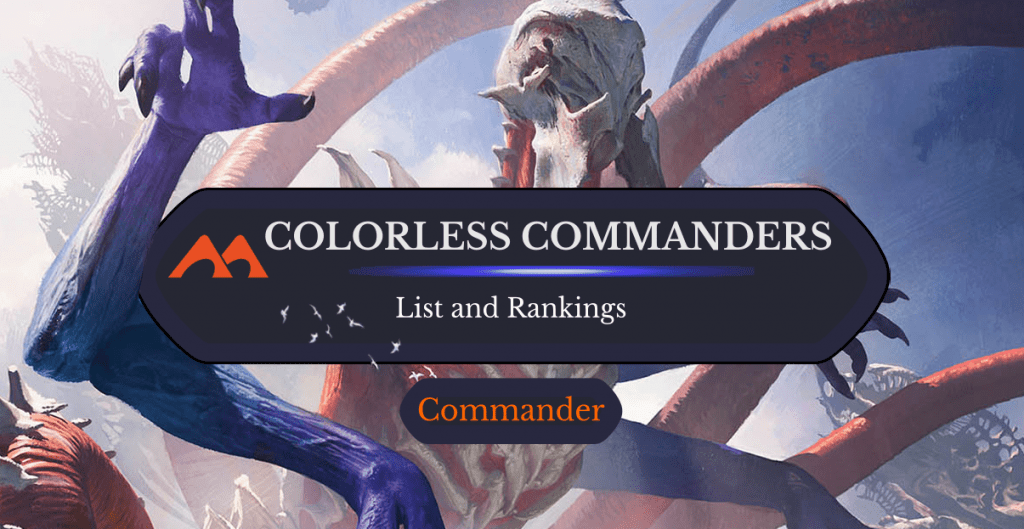
Ulamog, the Ceaseless Hunger | Illustration by Michael Komarck
One of the most important rules to keep in mind when brewing a Commander deck is the fact that every single card in your deck has to be within your commander’s color identity.
Let me give you a quick refresher in case you don’t know how color identity works. This is a concept that applies almost exclusively to the Commander format. A card’s color identity includes every mana symbol that’s present on the card, excluding reminder text. This means casting costs, ability costs, mana abilities that generate specific mana colors, etc. If a card has the symbol for a specific type of mana, then that color is part of the card’s color identity.
This still applies if you’re playing a colorless commander. And don’t get me wrong, I’m not talking about Ramos, Dragon Engine or Golos, Tireless Pilgrim. Those are 5-colored commanders.
I’m talking about completely colorless creatures without a single mana symbol on them.
What Are the Rules for Colorless Commanders?
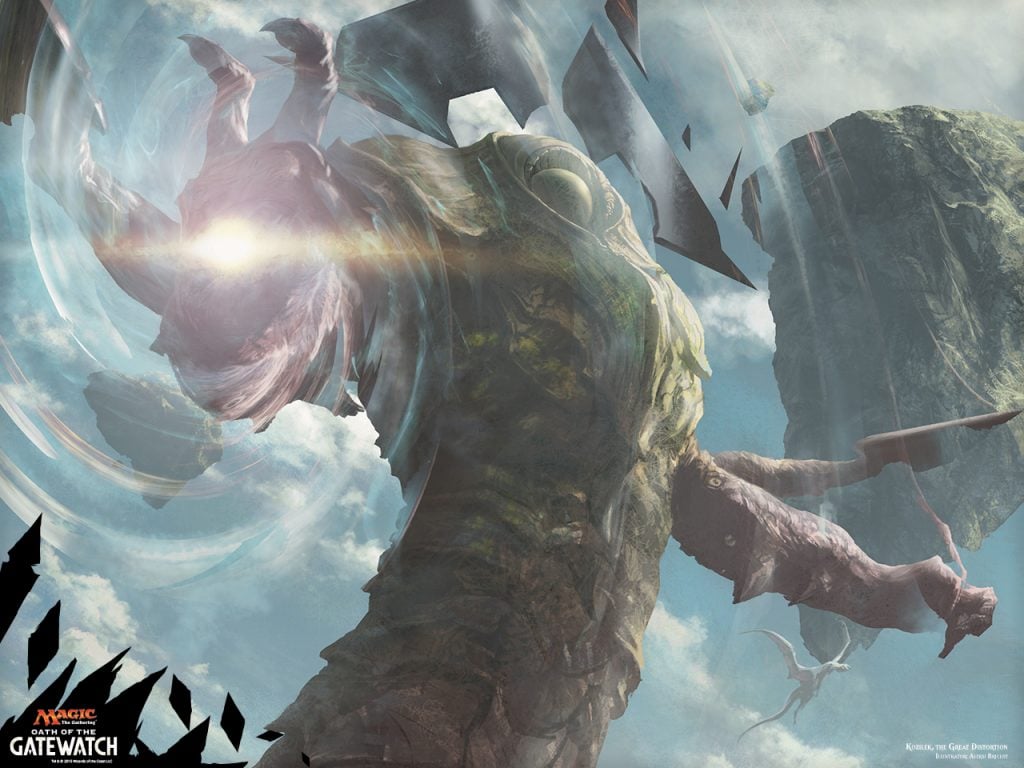
Kozilek, the Great Distortion | Illustration by Aleksi Briclot
The rules of Commander are the same for colorless commanders as for any other colors. This means playing with only colorless cards. And that’s what makes building a deck around a colorless commander very hard, but also very fun.
The strategy you choose for your deck varies depending on what legendary creature you choose as your commander. There aren’t a ton of possible colorless commanders, but there’s still some variety. What makes for an interesting deckbuilding exercise, though, is that any and all cards in your deck have to be completely colorless. There can’t be a single colored mana symbol in your deck.
As long as you make sure all of your cards are completely colorless then your deck should be fine to play within the official Commander rules. You can always ask your playgroup if they’re okay with you playing specific colorless cards with colored mana symbols (Lifecrafter's Bestiary, for example). It might mean having a Rule 0 discussion before the game, but some groups prefer discussing the rules to see if they can be bent instead of always sticking to them.
#18. The Prismatic Piper
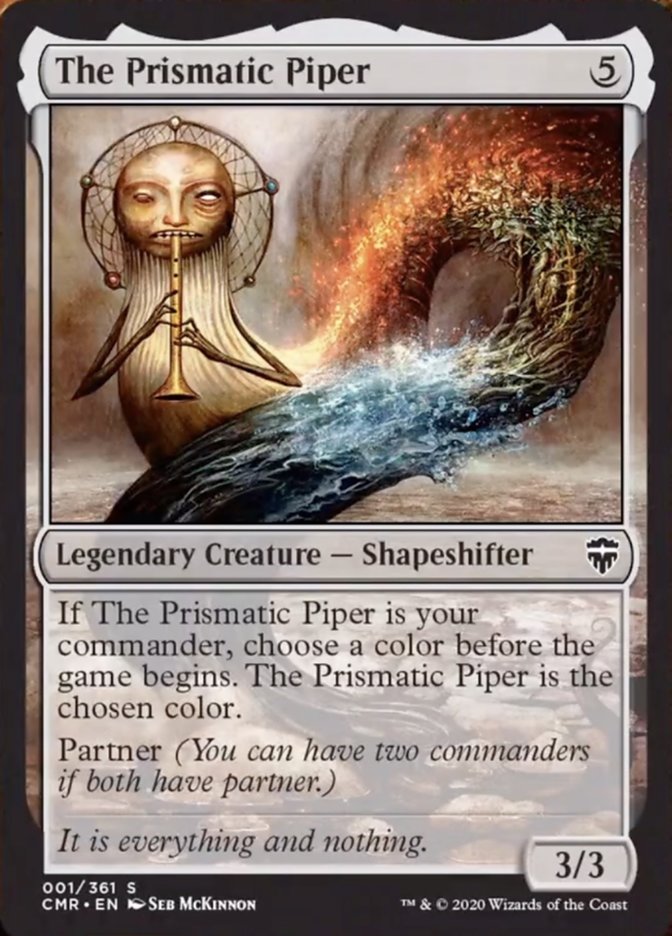
The Prismatic Piper’s only strengths lie in its partner and color-choosing abilities. It can work really well when partnered with other colored commanders and it’s a great way to add specific colors to a deck without using partner commanders who might come across as big threats.
When it comes to colorless decks, though, Piper is the lowest tier commander. It’s cheap and easy to get, so it’s reasonable if you want to build a colorless deck but the commander itself isn’t very important.
But as a commander itself, it has no useful or worthwhile abilities. And paying for a 3/3 isn’t exactly great.
#17. Faceless One

Faceless One is just The Prismatic Piper, but it’s an enchantment this time, and it replaced partner with “choose a background.” What a twist! To be fair, these cards exist to make sure players were guaranteed access to a commander in their respective Limited formats.
In Commander Legendsand Commander Legends: Battle for Baldur’s Gate, you were allowed to use these cards even if you didn’t draft them, similar to basic lands, in the off-chance you never drafted a legendary creature. They weren’t really designed with regular Commander games in mind.
#16. Hope of Ghirapur
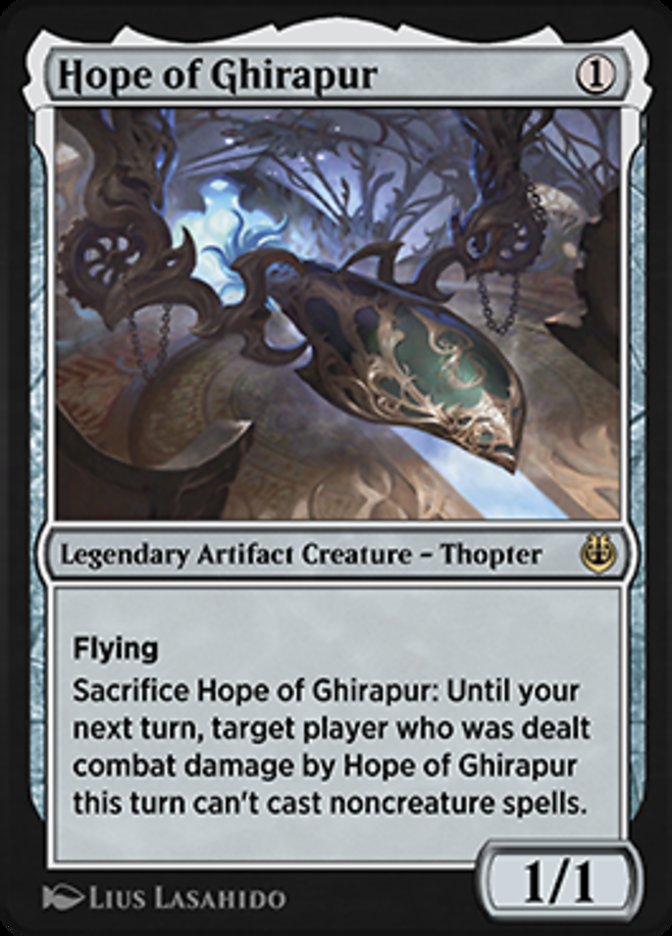
If The Prismatic Piper was jank, Hope of Ghirapur is slightly better jank. A 1/1 flier for is reasonable at best. This card’s second ability can be good in certain situations, but it’s not exactly a game-changer.
Arguably the best way to take advantage of Hope is to play a good Voltron deck or maybe a stax strategy. Voltron is pretty straightforward. Equip it into oblivion and back and then hit your opponents with your once unassuming thopter.
Stax commanders make it a bit more complex. The idea is to slow your opponents down until you can play something like Blightsteel Colossus or Darksteel Colossus. Hope of Ghirapur’s sacrifice ability can help you buy some time by stopping your opponents from playing anything that isn’t a creature or land.
#15. Omarthis, Ghostfire Initiate
Omarthis, Ghostfire Initiate is practically a growing vanilla commander that needs to die for you to get card advantage through manifest. In my experience, it's always harder than I want it to be to pull this off. With the double X cost, it is tough to get great value, so here are a few cards that sprang into mind immediately when ranking this card, Steel Overseer, Endless One, and Ugin's Conjurant.
#14. The Peregrine Dynamo
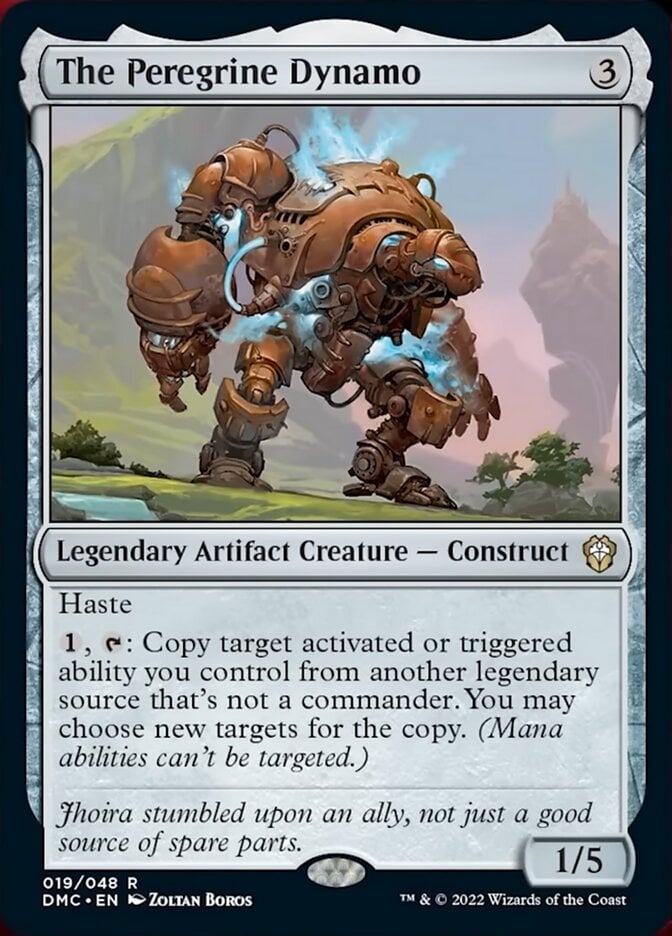
The Peregrine Dynamo works well with most of the other legends on this list, just not if they’re your commander. It’s a cheaper, better Strionic Resonator when it works, though it interacts with fewer cards.
When it does work, it can copy anything from the extra draw trigger on The Immortal Sun to an annihilator trigger from one of the eldrazi titans.
#13. Syr Ginger, the Meal Ender
The artifact death trigger is quite the build-around when we can sacrifice artifacts, and as someone who never had many planeswalkers to use, the first sentence of text on Syr Ginger, the Meal Ender is one of my favorites. I also like to play aggro and love a way to gain chunks of life back after I've been on the attack.
Good food can be simple. Try setting your table with Throne of Geth, Ichor Wellspring, and Myr Retriever. Be an adventurous chef and have fun.
#12. Clara Oswald
The Doctor Who companions are a flavorful variant of partner commanders. I'd be sad if Clara Oswald only had the Impossible Girl text, thankfully the additional doctor triggered ability is one worth building around. There are so many good triggered abilities on legendary WHO doctors, that it should be fun to choose a good pairing. I particularly enjoy untapping, so I would put Clara with The Ninth Doctor. Comment with your favorite combination.
#11. Traxos, Scourge of Kroog
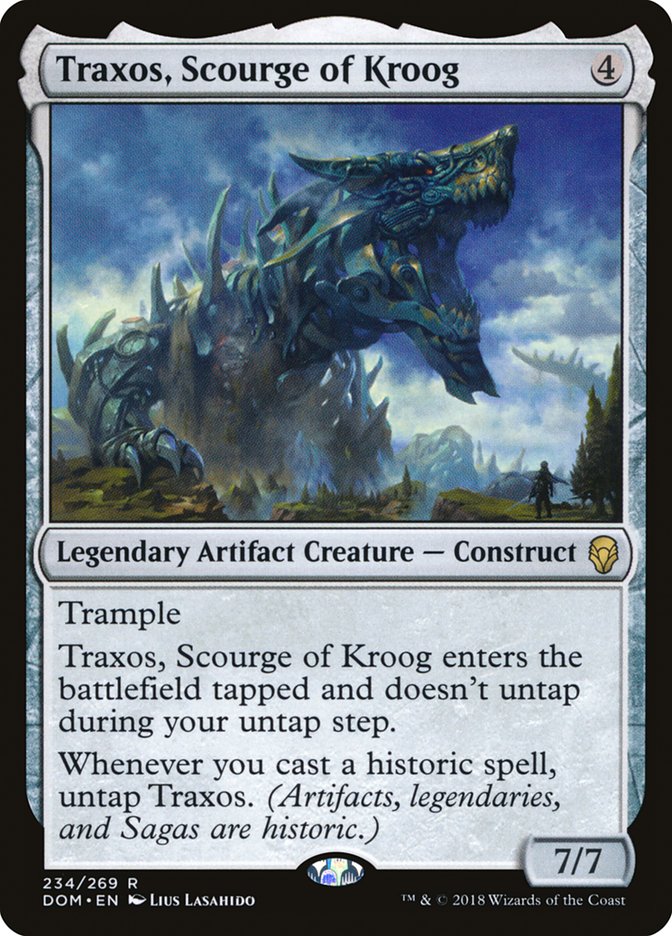
Artifacts are inevitably going to be a main feature of colorless decks. After all, they make up the bulk of colorless cards out there. But while some previous commanders use artifacts out of necessity, Traxos, Scourge of Kroog greatly benefits from you playing artifacts.
With the exception of Urza's Saga, most of the historic spells you can play in this deck are artifacts. With a good amount of mana generators and equipment, you can keep your Traxos constantly untapped while also covering it in equipment so it can quickly deal with opponents via commander damage.
#10. Graaz, Unstoppable Juggernaut
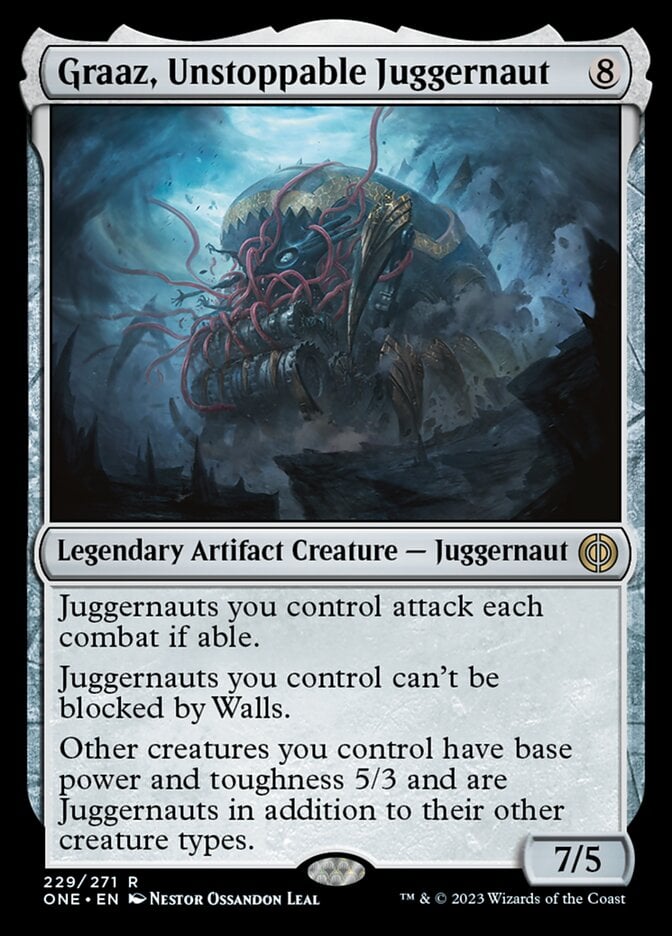
Craterhoof Behemoth, is that you? Not quite, but Graaz, Unstoppable Juggernaut is doing the best it can.
“Juggernauts matter” isn’t really a thing, so Graaz is best built around a supporting cast of cheap, scampy creature tokens like servos, thopters, and myr. It’ll feel like a big Overrun the turn it hits the board, though things go south quickly if Graaz dies mid-combat.
#9. Zhulodok, Void Gorger
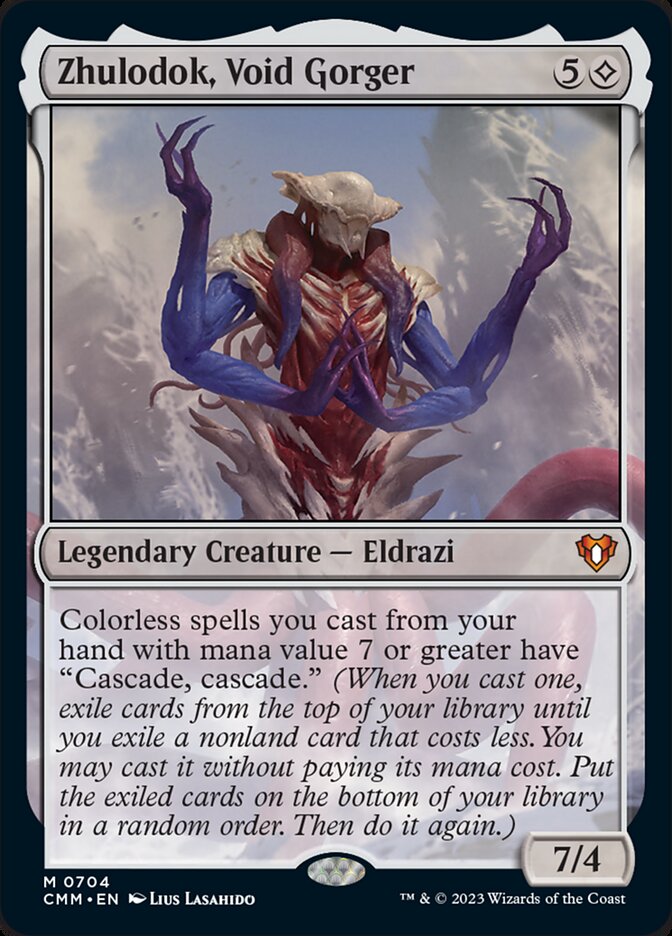
Zhulodok, Void Gorger isn’t as powerful as some of the more popular eldrazi titans, but look at those things. It does, however, make your best cards even better, putting it somewhat in “win-more” territory.
It lacks protection and won’t usually make an immediate impact on a game, but when it survives a full turn cycle it’s likely to create an insurmountable advantage.
#8. Kozilek, the Great Distortion

Players are scared to the moon and back of eldrazi. You’re gonna get focused really hard if you play one in a Commander game. Unless you play Rakdos, Lord of Riots and manage to play five or six eldrazi all at once and make your entire table simply concede. But that’s a story for another time.
Kozilek, the Great Distortion is arguably on the softer end when it comes to the world-eating titans. It’s not a weak card by any means but most players would probably recommend running any other eldrazi legendary creature as your commander without taking card prices into account.
What makes this particular card interesting is that, unlike most colorless cards, it allows you to interact with your opponents. Drawing into a full hand whenever you cast it is already a great ability. But what you should care about is the fact that it lets you counter spells without having to use any colored mana.
I prefer this card as part of the 99, but it’s more budget-friendly than other more powerful colorless commanders and it’s still super strong. Use it with cards like Void Winnower and Meteor Golem to run a control-style game. And have cards with varied mana values so that you always have counters available.
If you want to read more about this powerful eldrazi, we have an entire deck guide on Kozilek here.
#7. Karn, Silver Golem

As with all versions of Karn, Karn, Silver Golem focuses on artifacts. Specifically non-creature artifacts.
Let’s not kid ourselves. Almost all colorless Commander decks are gonna have some must-have win conditions. Things like Blightsteel Colossus and Wurmcoil Engine. You can’t run one of these decks without powerhouses like them. But Karn, Silver Golem allows you to create powerhouses out of other cards.
We all know Darksteel Forge is insanely powerful in an artifact deck. But paying nine mana for a simple utility artifact? Not enough for Karn. Use its second ability to turn it into a large creature and fling it at your opponents.
There’s no shortage of artifacts with high mana values. There are also plenty of ways to cheapen those costs or cheat those artifacts onto the battlefield. And then all you need is a single mana for each to turn them into some heavy-hitting creatures.
#6. Liberator, Urza’s Battlethopter
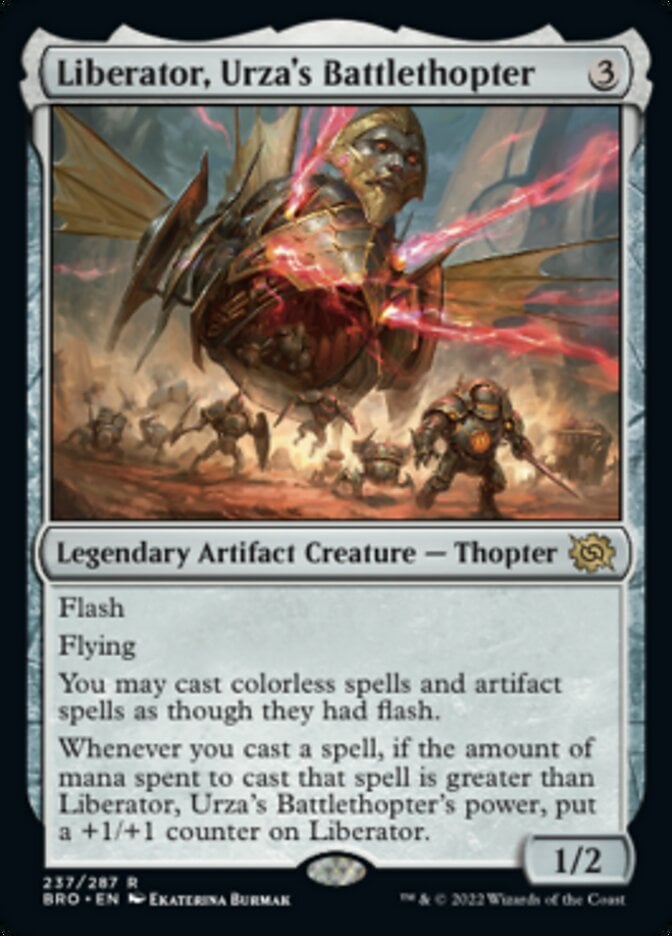
Liberator, Urza's Battlethopter is a point of power off from being a strictly better Shimmer Myr, one you can run as your commander no less.
Liberator’s ability is better, extending flash to regular colorless spells in addition to artifacts. It also grows as you cast colorless spells with cascading mana values, making commander damage a viable avenue to victory.
#5. Karn, Legacy Reforged

Blinkmoth Urn has never looked so good. Karn, Legacy Reforged is at minimum a 5/5, scaling in power with more expensive artifacts but rewarding decks full of cheap artifacts by generating more mana with its upkeep trigger.
This trigger encourages dynamic deckbuilding that rewards a diverse curve of early-game plays to flood the board with artifacts, and late-game finishers to filter the extra colorless mana into.
#4. Ulamog, the Infinite Gyre

By now you’ve probably noticed a big issue with colorless decks. You’re either playing commanders that are just good enough but nowhere near the raw power of many colored commanders, or you’re playing insane powerhouses that are gonna see you perceived as an instant threat before the game even starts. The remaining cards are prime examples of commanders that will put you in the crosshairs.
The moment Ulamog, the Infinite Gyre hits the stack you can destroy any permanent an opponent controls. That’s already pretty threatening for a commander that you can repeatedly cast given enough mana. Follow that with the much-dreaded annihilator ability that makes opponents sacrifice permanents whenever it attacks, indestructible, and the possibility to shuffle your entire graveyard into your deck when it dies.
Yeah, eldrazi may be expensive but damn they’re overpowered sometimes.
#3. Kozilek, Butcher of Truth
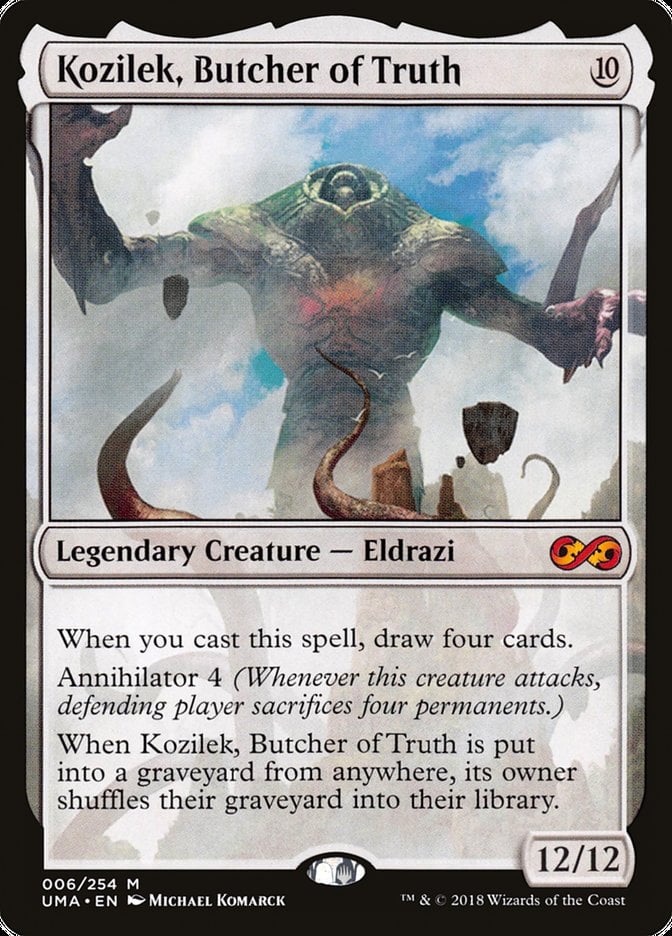
I prefer this iteration of Kozilek to Kozilek, the Great Distortion. Drawing four cards regardless of how many you have in your hand is better than essentially drawing seven minus the number of cards in your hand. And annihilator is usually better than menace.
Kozilek, Butcher of Truth unfortunately doesn’t have the fun (and annoying) ability to counter your opponents’ spells. That’s a big drawback, especially when it comes to the fun factor, since it limits Kozilek’s interaction to attacking and triggering annihilator. I think even with that this card stands as the more powerful version of Kozilek.
#2. Emrakul, the Promised End
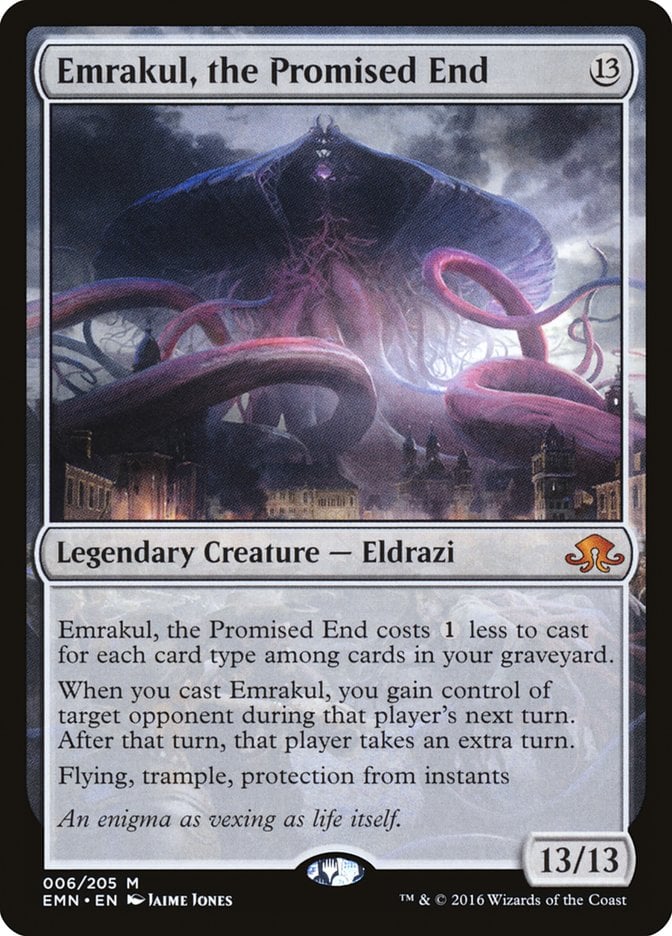
Playing Emrakul, the Promised End in a colorless deck doesn’t allow you to take advantage of its first ability all that much. There’s probably not gonna be a lot of card types in your graveyard since colorless has very limited access to anything that isn’t a creature or an artifact.
Even so, this is an incredibly powerful card. Protection from instants gives an amazing shield from a ton of removal cards while trample and flying give this massive hitter a ton of evasion. You also get to control an opponent’s next turn. You can do some real damage if you use it correctly.
The Promised End comes with a pretty reasonable drawback: The opponent whose turn you just used gets an extra turn after that one. That way they still get a chance to actually do something even though you can screw up their entire strategy. This can still be a good thing since it’s a great way to play politics with the other players.
#1. Ulamog, the Ceaseless Hunger

There’s something about Ulamog, the Ceaseless Hunger that makes me fear it a lot more than all the other colorless commanders. Being able to exile two permanents right off the bat when you cast it is absolutely incredible.
I know its mana cost is absurdly high, but this card as your commander means having the ability to exile any two permanents from the field at almost any given time. Add to that a 10/10 stat-line with indestructible that can essentially make a deck useless in one swing and you’ve got one hell of a commander on your hands.
The main thing about the Ceaseless Hunger is that it’s hard to keep it on the battlefield for more than one or two turns. But it’s not as impossible as it would be with the other commanders that don’t have indestructible.
A lot of EDH players run exile effects or ones that force you to sacrifice your permanents, and Ulamog is gonna get focused on quite a lot with that. It’s still immune to most board wipes and single-target removal. And I have to remind you that your opponent loses a fifth of their deck every time you swing at them. You should be able to exile their entire library pretty quickly.
(Dis)Honorable Mention: Emrakul, the Aeons Torn

If you’re wondering why I didn’t mention the greatest of the eldrazi titans as a possible commander, I have bad news for you.
Emrakul, the Aeons Torn is banned in Commander. The card is considered extremely unfun to play against since it essentially breaks the game and can win out of nowhere. It’s even been said that the Aeons Torn goes against everything the format stands for.
If it wasn’t banned, good ol’ Emrakul would be my pick for the number one colorless commander. It can’t be countered, it’s a flying 15/15 with protection from colored spells (which means protection from single-target removal), it can put your graveyard back into your deck then go back into the command zone when it dies, and it gives you an extra turn when you cast it.
Oh, and it has annihilator 6. Y’know, just in case everything else wasn’t quite enough.
(Un)Honorable Mention: D00-DL, Caricaturist
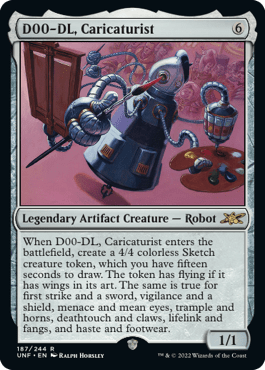
Doodle, get it? D00-DL, Caricaturist, which we can all agree to call DoodleBot, is an Unfinity commander with an acorn stamp that bans it from the format. “Art matters” isn’t the most farfetched thing an Un-set card could care about, and DoodleBot is pretty tame in terms of its in-game effect. You’ll want to discuss playing this in a casual pod with the other players, but I don’t see anything too offensive about it.
Why Are There So Few Colorless Commanders?
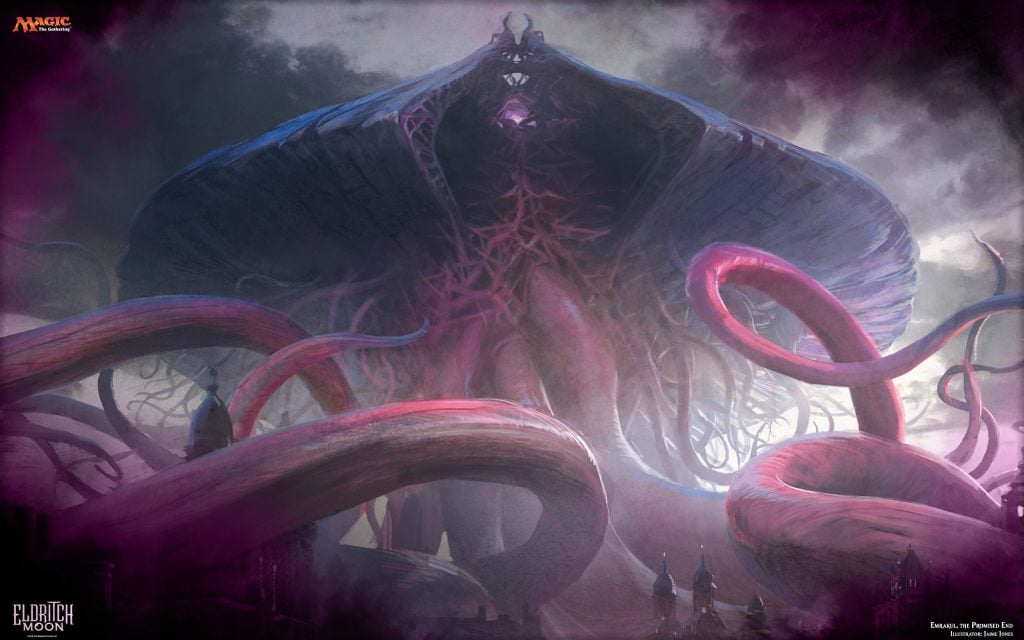
Emrakul, the Promised End | Illustration by Jaime Jones
I’ve tried to hunt down where the design team talked about the lack of colorless commanders in Magic, but there’s not much on the subject. I do have some theories and opinions, though.
Colorless cards are a tricky thing in magic. The colors in a card’s casting and ability costs tend to lean towards certain color pie ideals, an affinity to particular strategies and design sensibilities, or exist to be more prohibiting. You shouldn’t be able to play every single possible strategy and play style in a single color. Colors are there to tell us a lot about a card’s playstyle, its adjacent strategies, and even about the characters, actions, and all-around scenes depicted in them.
This puts colorless cards in a sort of neutral zone. Colorless creatures are usually artifact creatures with little to no autonomy. The ones that do have some autonomy still usually choose to remain as neutral as possible. And their cards are meant to reflect that.
The Eldrazi
It works pretty similarly with the eldrazi. They’re unfeeling, immense entities that destroy worlds. They don’t strategize or plan their attacks, they just consume everything in their path. This is what makes them colorless.
And when the designers at Wizards wanted to give us a greater variety of eldrazi they included the “devoid” ability. This prevented certain strategies and playstyles outside of their corresponding colors while keeping eldrazi colorless, mechanically and lore-wise. It also showed a morphing of the eldrazi corruption with the mana of the plane they were trapped in.
Flavoring the Flavorless
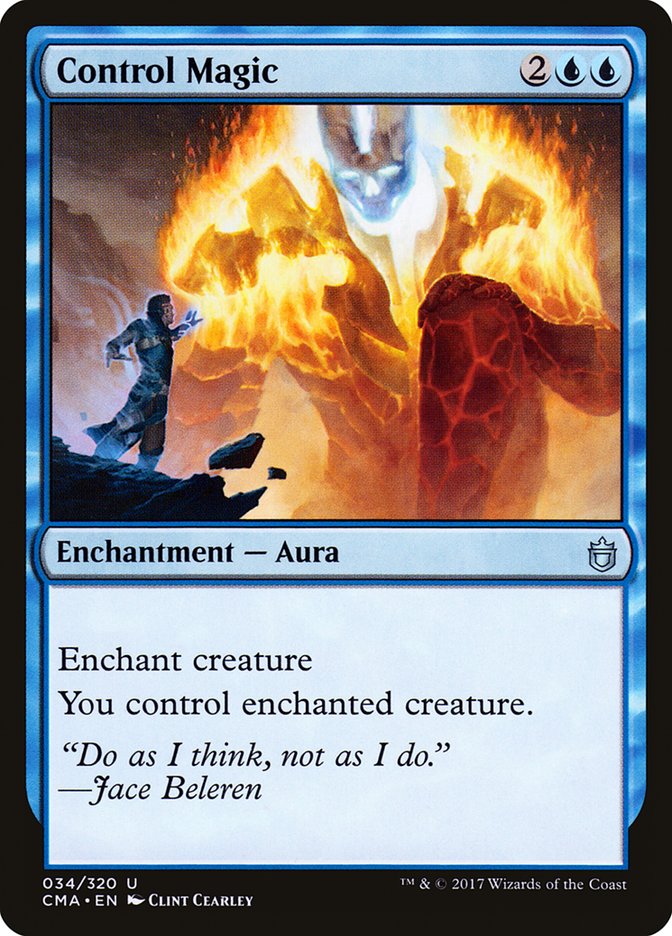
What I’m trying to say is that colorless cards basically need to have a specific play style and flavor just like any other color. For example, Control Magic abilities should need blue mana since it’s the color that allows for that kind of effect. If colorless cards could draw from strategies that are usually associated with specific colors, it’d allow the rest of the color pie access to things that it usually shouldn’t have. That’s what happened with Phyrexian mana and it’s now mostly considered a design mistake thanks to exactly that.
So legendary colorless creatures that are actually allowed to do good things become harder to design. A lot of colorless creatures use or generate colored mana for their abilities. This means their color identity is technically those colors and not really colorless. A truly colorless creature needs to be unaligned with what the five colors of Magic can do, and it can’t do something neutral and particularly powerful for a cheap cost since that would be easily exploitable.
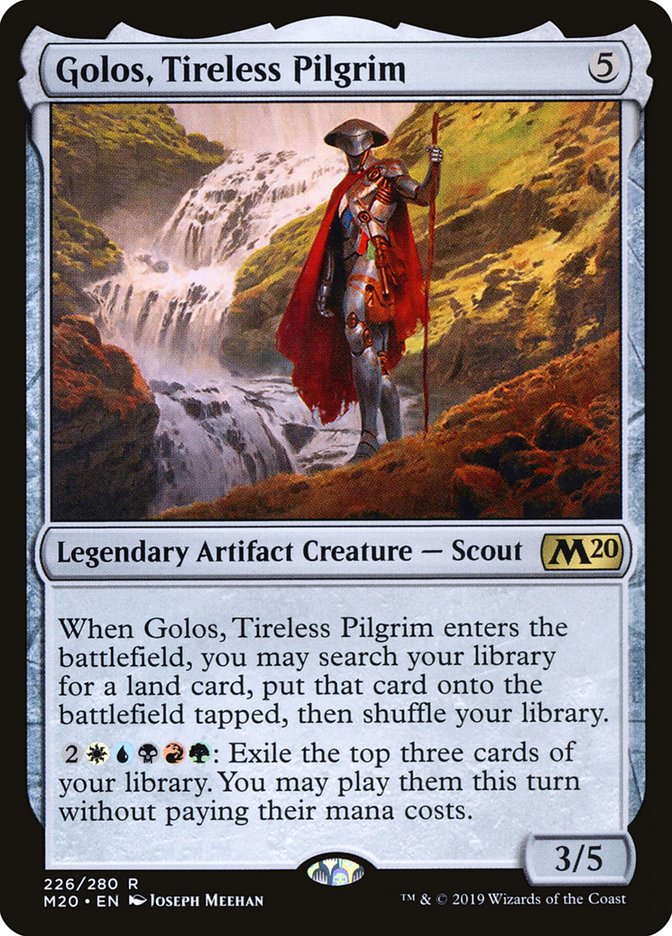
All of this results in us having almost no colorless commanders and most (if not all) of them having a focus on artifacts or being eldrazi. This inherent “brokenness” to powerful colorless cards is what infamously got Golos, Tireless Pilgrim banned from Commander.
Generic Mana Symbols vs. Colorless Mana
We were introduced to colorless mana back in Oath of the Gatewatch. This retroactively changed a lot of mana-generating artifacts and abilities as well as the way mana worked when playing certain colorless spells.
Take a look at Kozilek, Butcher of Truth and Kozilek, the Great Distortion. They both have a mana value of 10. Neither of them require any of the five colors to be played. But if you control 10 Forests, you can absolutely cast Butcher of Truth. The Great Distortion? Not gonna do so well.
You need specifically colorless mana to cast the latest version of Kozilek. This is created by a sixth basic land type that was introduced in Oath of the Gatewatch: Wastes. You can also get this mana from artifacts that used to generate generic mana and got errata’d. Sol Ring is a Commander staple that originally produced two generic mana, but now produces colorless mana.
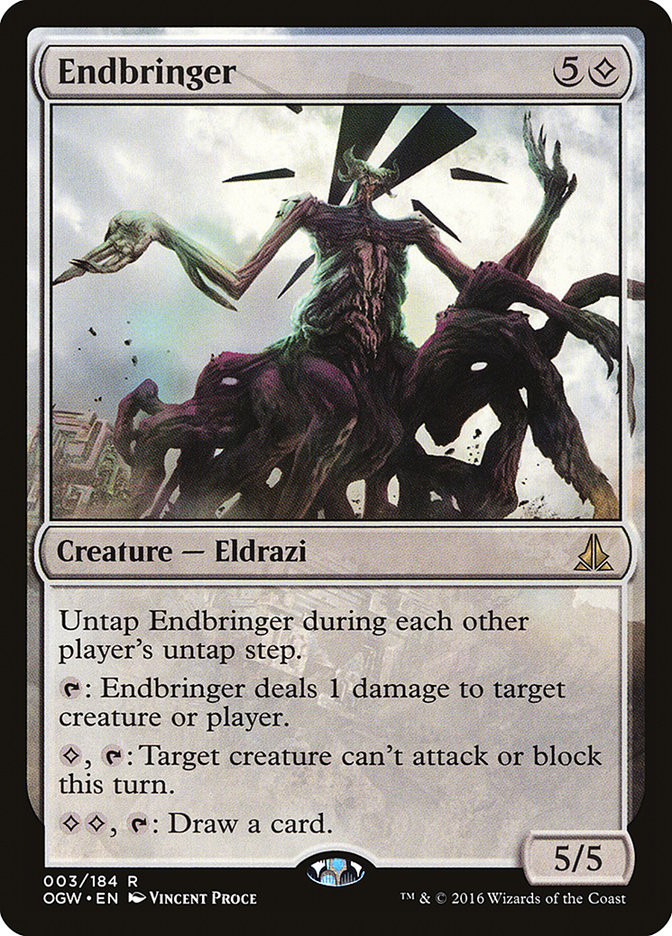
The main difference between these two Kozileks is that generic mana can be paid by mana of any color, including colorless, while colorless mana costs can only be paid for with colorless mana as if it was a sixth color in the color pie. This makes certain colorless cards harder to cast in colored decks, forcing you to build with the understanding that throwing in an Endbringer means you need to be prepared to generate colorless mana.
Can You Put Lands with Colorless Color Identity in Your Deck with a Colored Commander?
Colorless mana symbols don’t count towards color identity. They’re relevant to some casting and ability costs, but colorless still isn’t a color in Magic. To reuse my example from before, you can play both versions of Kozilek in a mono-green deck.
You might need to make sure you have Sol Ring or Thran Dynamo on the field to cast Kozilek, the Great Distortion since you need colorless mana. But its colorless identity won’t interfere with you putting it in a colored deck, only how you build that deck to cast it.

This means that you can absolutely put lands and artifacts that generate colorless mana in decks of any color. At the risk of repeating myself a bit, Sol Ring generates colorless mana and it’s a must-have in almost any EDH deck.
What Does Command Tower Do if I Have a Colorless Commander?

Command Tower does nothing if your commander is colorless. Colorless isn’t a color (it’s literally a lack of color) and the Tower specifically says that it generates mana of your commander’s color identity.
So no color identity means no mana. There are a ton of other lands you can put in a colorless deck that will actually generate mana.
Decklist: Traxos Artifacts in Historic
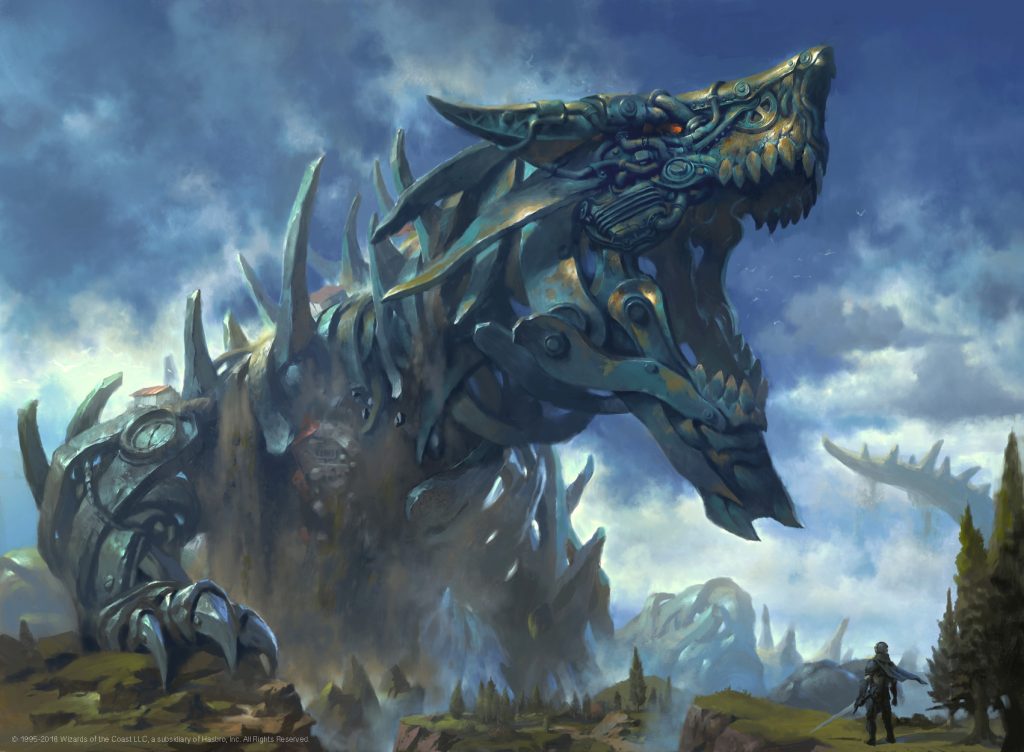
Traxos, Scourge of Kroog | Illustration by Lius Lasahido
Commander (1)
Creatures (28)
Brass Squire
Burnished Hart
Chief of the Foundry
Darksteel Juggernaut
Duplicant
Endbringer
Filigree Familiar
Foundry Inspector
Hedron Crawler
Jhoira's Familiar
Manakin
Metalwork Colossus
Meteor Golem
Mishra's Self-Replicator
Myr Battlesphere
Myr Retriever
Ornithopter
Ornithopter of Paradise
Palladium Myr
Salvager of Ruin
Scrap Trawler
Scrapyard Recombiner
Shambling Suit
Shimmer Myr
Steel Hellkite
Steel Overseer
Voltaic Servant
Workshop Assistant
Instants (2)
Scour from Existence
Titan's Presence
Sorceries (4)
Expanded Anatomy
Gruesome Slaughter
Introduction to Annihilation
Introduction to Prophecy
Artifacts (28)
Argentum Armor
Blackblade Reforged
Clock of Omens
Ebony Fly
Everflowing Chalice
Fireshrieker
Ghostfire Blade
God-Pharaoh's Statue
Hedron Archive
Ichor Wellspring
Infiltration Lens
Lightning Greaves
Manifold Key
Mask of Memory
Mind Stone
Moonsilver Key
Nevinyrral's Disk
Pristine Talisman
Rogue's Gloves
Sculpting Steel
Sol Ring
Spine of Ish Sah
Swiftfoot Boots
Sword of Vengeance
Thran Temporal Gateway
Trading Post
Unstable Obelisk
Voltaic Key
Lands (37)
Aether Hub
Arch of Orazca
Ash Barrens
Buried Ruin
Cave of Temptation
Crawling Barrens
Cryptic Caves
Darksteel Citadel
Detection Tower
Dread Statuary
Emergence Zone
Encroaching Wastes
Forge of Heroes
Guildless Commons
Haunted Fengraf
Holdout Settlement
Labyrinth of Skophos
Mage-Ring Network
Mirrodin's Core
Myriad Landscape
Nephalia Academy
Painted Bluffs
Phyrexia's Core
Radiant Fountain
Rogue's Passage
Ruins of Oran-Rief
Scavenger Grounds
Sea Gate Wreckage
Shimmering Grotto
Shrine of the Forsaken Gods
Temple of the False God
Thespian's Stage
Tomb of the Spirit Dragon
Tyrite Sanctum
Unknown Shores
Warped Landscape
Zhalfirin Void
I’ve put together a colorless deck so you can more or less see what direction it might take. I tried to keep it under $50 and used almost no cards that cost over $1 so a lot of staples like Sol Ring are missing.
This is a pretty straightforward deck. Play a lot of artifacts and artifact creatures. Play Traxos, Scourge of Kroog and keep it almost constantly untapped. Equip Traxos to make it a proper threat and get commander damage in to take out your opponents.
This is a casual deck that I built pretty quickly and for as cheap as possible, but it’s still playable if you’re with a casual group. You can use it as a base to expand upon and come up with your own lists or take advantage of cards you already own. Feel free to use it however you want!
Wrap Up

Hope of Ghirapur | Illustration by Lius Lasahido
I love colorless decks. I’ve played against colorless decks in MTG Arena Standard and they’ve been some of my favorite games in a long time. It takes a lot of imagination and work to build a good colorless deck, but you can come up with a really interesting and honestly pretty powerful deck with enough thought. And money.
I’d love to see some proper support for colorless as a strategy beyond eldrazi and artifacts, but that seems unlikely for the time being. Thankfully, Commander Masters gave a little love to colorless commanders.
What do you think? Do you have a colorless deck or would you like to have one? Or are the commanders available not up your alley? Feel free to comment down below, and don’t forget to check our blog for more content like this.
That’s all from me for now! Stay safe, have a good one, and remember: never use Rakdos, Lord of Riots to play a handful of eldrazi for free. If you want to keep your friends, that is.
I’ll see you in the next one!
Follow Draftsim for awesome articles and set updates:
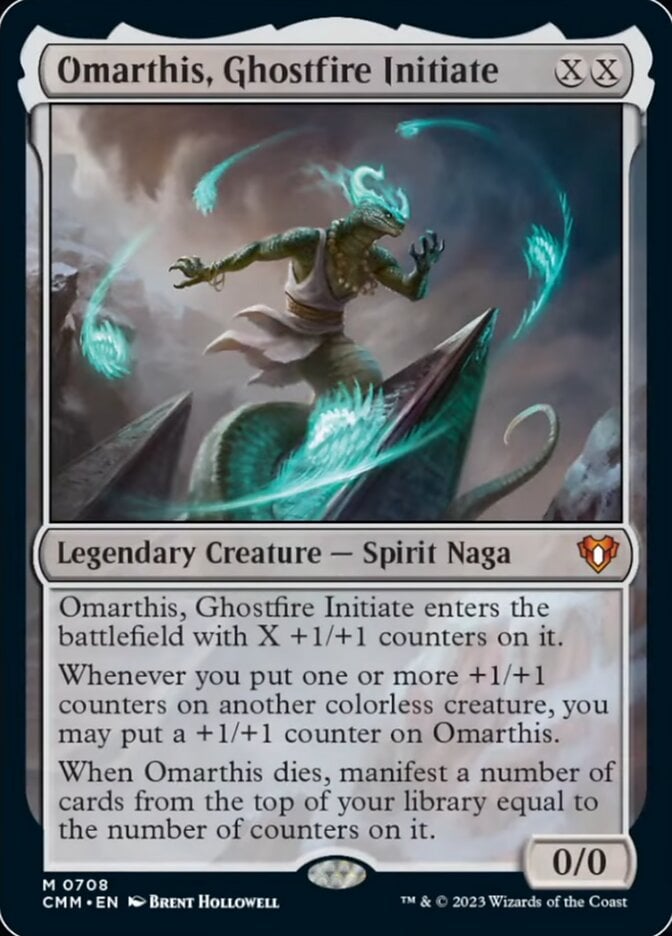
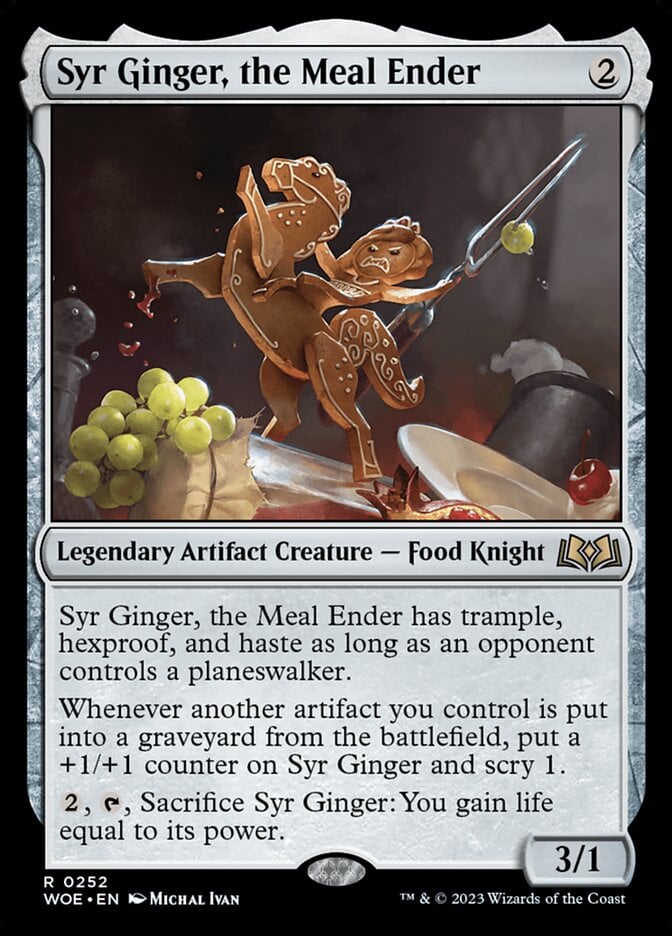
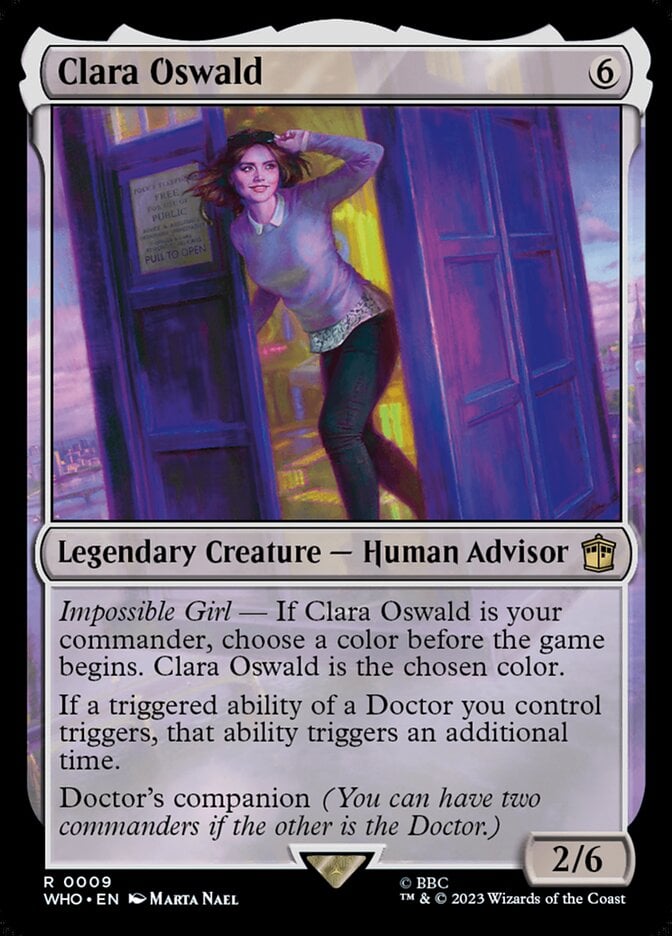
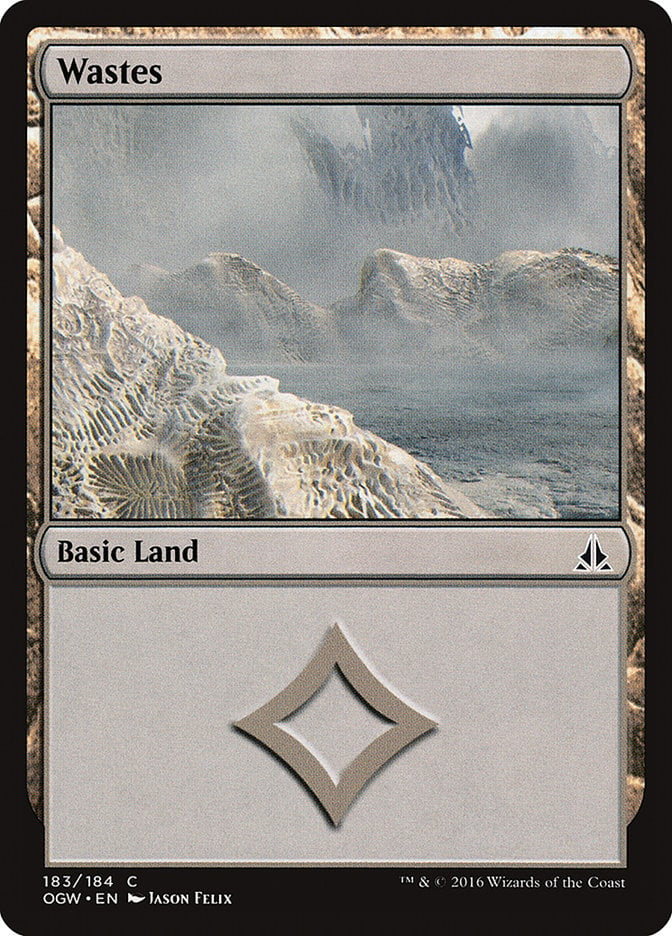

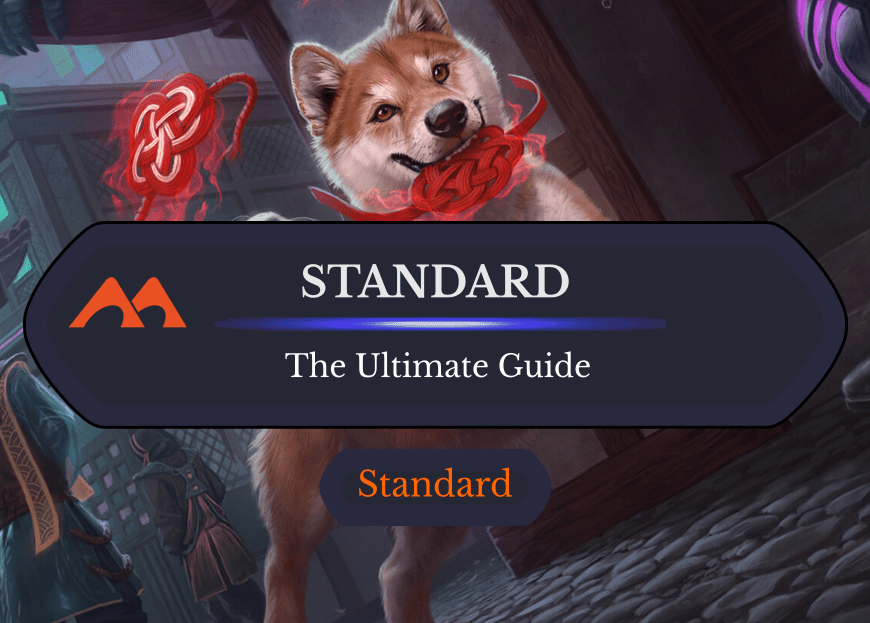

Add Comment